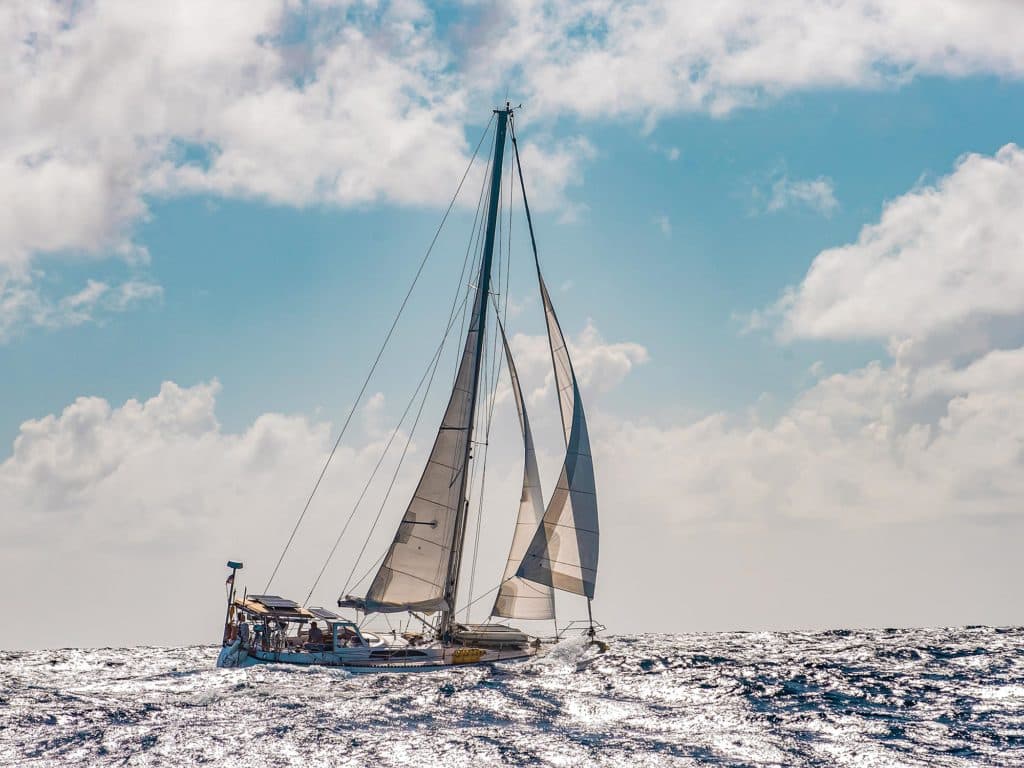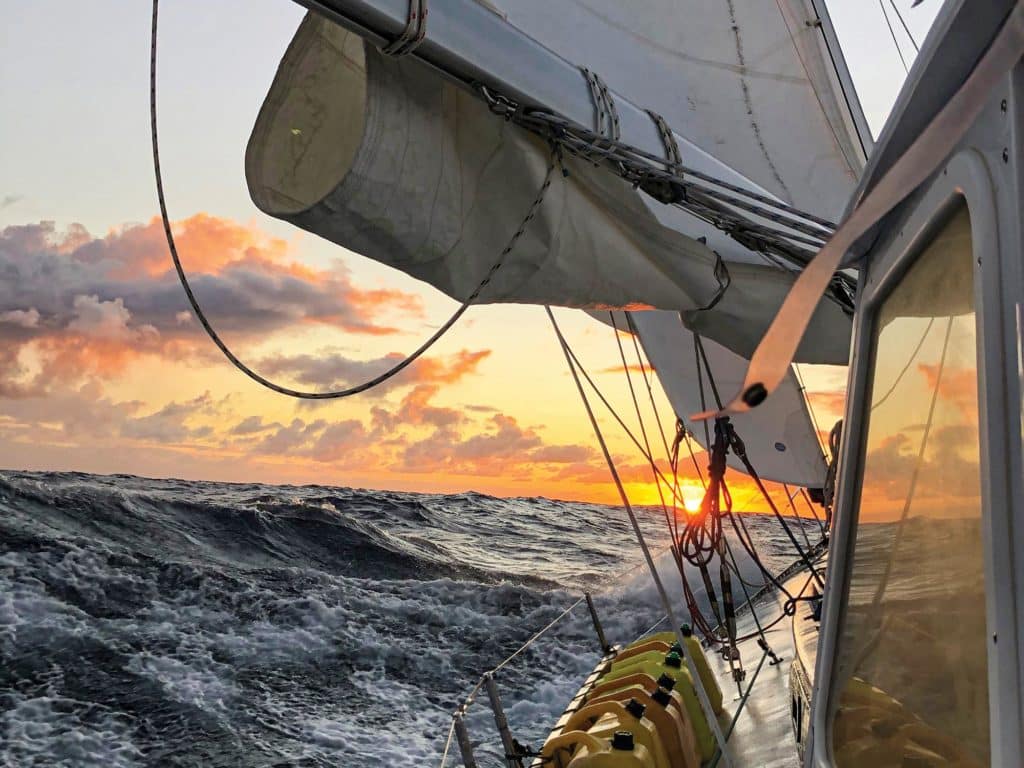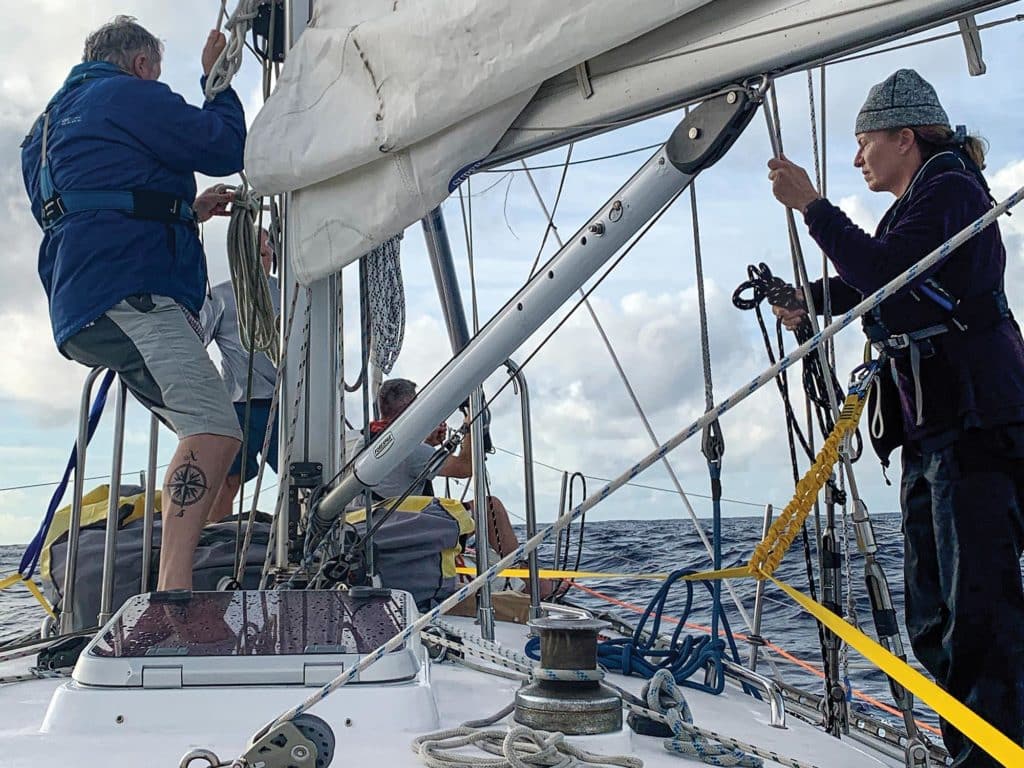
The morning breeze was light as we ghosted past Sable Island. The mainsail and asymmetrical spinnaker were keeping us moving off the Canadian coast, and we embraced the moment, knowing it wouldn’t last. Wind was coming our way: The forecast called for near-gale-force winds by midnight. We were bound for St. John’s, Newfoundland, 400 miles across the Grand Banks.
By late afternoon, with the apparent winds steady at 18 knots, we doused the spinnaker, unfurled the genoa, and set the whisker pole. By evening twilight, it was time to reef the main. Quetzal, our Kaufman 47 cutter, is fitted with traditional slab reefing. We were on a sweet reach with the apparent winds 110 degrees off on port tack. Without changing course—that’s right, keeping the apparent winds well abaft the beam—we tied the first reef in the main and rolled in a bit of headsail. A few hours later, with the winds steady at 25 knots, we furled the genoa completely, dropped the pole, unfurled the staysail, and tied the second reef in the main. We didn’t change our heading and didn’t flog a sail. The wind kept building and, just past midnight, increased to 30 knots sustained with gusts in the low 40s.
We were flying, punching out double-digit speeds, but it was a rough ride. The Grand Banks is infamous for raising nasty seas in a hurry. It was time for the third reef in the main. The idea of coming up into the wind to reef in those conditions was madness. While still on port tack, the winds had clocked slightly to about 90 degrees off. We fell off a bit to tie in the third reef before resuming course. We also rolled in a bit of staysail, to keep the sails balanced. The boat settled down, and we charged through the night sailing fast but in control. As conditions moderated, we shed reefs in the same fashion, off the wind without flogging or drama.
When we reached St. John’s, we learned of the tragedy of the CNB 66 Escape. Just a week earlier, while on passage from Bermuda to Nova Scotia, husband-and-wife owners Karl and Annamarie Frank died from injuries sustained while trying to reef the main head to wind in a Gulf Stream gale. It’s a profoundly heartbreaking story. Reports indicated a struggle with the headsail and boom furling systems. The ensuing chaos of a flogging headsail, the boat rounding up violently, and a wildly out of control mainsheet proved a deadly combination. (For more, see “Deep Thoughts” by Herb McCormick, Cruising World, October.)

The tragedy triggered a sober discussion on Quetzal. Coming upwind in those conditions to reef the main comes with a mountain of risk. For that reason, we always reef off the wind. It’s a proven technique; we’ve completed 161 offshore training passages aboard Quetzal and logged more than 150,000 miles. We’ve encountered several deep ocean storms. Reefing off the wind requires good gear and the coordination of several moving parts, but it is not a difficult process.
However, before we discuss the details, it is critical to understand that falling off the wind, to flatten and stabilize the boat, should be the first step in nearly every offshore sailing maneuver. We are taught to come up into the wind to deal with issues, including reefing the main. To my experience, it’s almost always a bad idea. Sailboats are remarkably stable with the wind abaft the beam, and the apparent loads are dramatically reduced. Flogging your sails and running rigging is dangerous on any boat, but especially on a big boat.
Our strategy for reefing off the wind begins by steering down (or up, if we’re on a deep reach) to 100 to 110 degrees off the apparent wind, and making sure the boat is happy on that heading. We dump the traveler to leeward to shorten the mainsheet, and we tighten the preventer to keep the boom under control. The boom preventer is always deployed when reaching, and it runs from the end of the boom forward to a fitting near the bow and back to the cockpit. If you don’t have a rigid vang, make sure the topping lift is relatively tight. With the boom secured, it’s time to reef.
Our main halyard is led aft to the cockpit. As it’s eased, the reefing outhaul, which is also led aft, is tensioned. It does not need to be a simultaneous operation, and the more slack in the halyard, the easier it is to secure the reef outhaul. The sail might bunch a bit as it drops, and occasionally, the sheet needs to be eased to reduce tension, but the sail never flogs, and there’s no tendency for the boat to round up. We don’t lead a separate reef tack line aft, so someone goes forward and secures the tack to the rams horn. With the boat flat, it is not dangerous to make your way forward. Sometimes, a bit of tugging along the luff helps the sail drop, but usually at this wind angle, the sail drops on its own.
Once the tack is secure, and the reef outhaul tight to the boom, the halyard is slowly hoisted. A bit of sheet control might be required as the sail goes back up. Once the halyard is tensioned, we stay off the wind and rig reefing ties, making sure not to lead them around the boom. They’re not for sail shape, just for gathering loose sail.
With the reef deployed, we take a minute to make sure everything looks right. Reefing isn’t frantic when you’re off the wind. When we are satisfied, we trim sails and resume course.
Naturally, there are nuances. Reefing off the wind means that loads stay under tension. You need stout gear, from halyards and blocks to winches and clutches. Also, always reef early, because doing so is the essence of good seamanship. I have a simple rule: If the thought of reefing flashes through my brain, even for an instant, I reef.
With slab reefing systems, the first reef is the most challenging. You are dealing with more sail area, so the sooner you take it, the better. Taking the second reef is significantly easier if the first reef is in place. The same goes for the third reef. Also, the sail flakes better on the boom when it’s reefed sequentially.
Quality mainsail cars and a slippery track are vital for effective reefing off the wind, especially if you have a full-battened mainsail. Full battens create side load on the cars, and I am not sure why bluewater cruisers insist on full-batten mainsails. Quetzal has a “two plus two” main, with the top two battens full (where you need them the most) and the bottom two partial, allowing us to reef off the wind with ease.

Selden, Harken, Ronstan and others make ball-bearing cars for full-battened mains facilitating off-the-wind reefing. Replacing the main halyard with smaller-diameter, less-stretchy Dyneema, and replacing the sheaves at the masthead and in the boom, will reduce friction. Tides Marine offers a one-piece, low-friction, ultra-high molecular weight (UHMW) track with custom slides and batten receptacles that can be added to almost any mast.
Friction is your enemy reefing off the wind, which is why I don’t like single-line slab reefing systems. There are too many turns, adding friction at every bend. Lazy jacks are also problematic for reefing off the wind. Quetzal is fitted with retractable lazy jacks that are quick to deploy for dropping the sail, and easy to retract when sailing. If your boat is fitted with a lazy bag and fixed lazy jacks, talk to your sailmaker about finding a way to retract them for offshore sailing.
In-mast furling systems are ideal for off-the-wind reefing. You need to maintain balance between the outhaul, furling line and mainsheet as you reduce sail. Back in my delivery skipper days, I made several Atlantic crossings with in-mast furlers, and successfully reefed off the wind using the same principles used for slab reefing.
Remember: In every off-the-wind reefing situation, start with establishing boom control. Off-the-wind reefing with in-boom furling is more challenging. The tragic tale of Escape is a graphic example of trying to cope with a boom furler on a big boat in heavy weather. However, it can be done. I recently sailed a Tayana 48 across the Atlantic and a Hylas 49 from Hawaii to Seattle. Both were fitted with boom furlers, and we consistently reefed the main off the wind. Boom angle and the coordination between the furling line, which is almost always controlled by an electric winch, the halyard and the preventer, is critical. You need to be patient, and you can be if you are not on the wind flogging sails and plunging into waves.
Manually turning the furling winch is hard work, but it gives you more feel as you reef, and sensing resistance helps prevent the sail from running forward at the gooseneck. Also, sheeting the headsail tight, despite being well off the wind, backwinds the main, which helps it reef more smoothly. Reefing early and incrementally is paramount with in-boom furling.
Fitting your mainsail for off-the-wind reefing, and practicing the technique in moderate conditions, will make your next offshore voyage safer and less stressful.
John Kretschmer has been sailing professionally for 40 years, logging 400,000 miles and completing his 30th Atlantic crossing this past summer. He is the author of the international bestseller Sailing a Serious Ocean. John Kretschmer Sailing offers training passages, workshops, webinars and Captain’s Hour—a monthly meeting about all aspects of offshore sailing.








